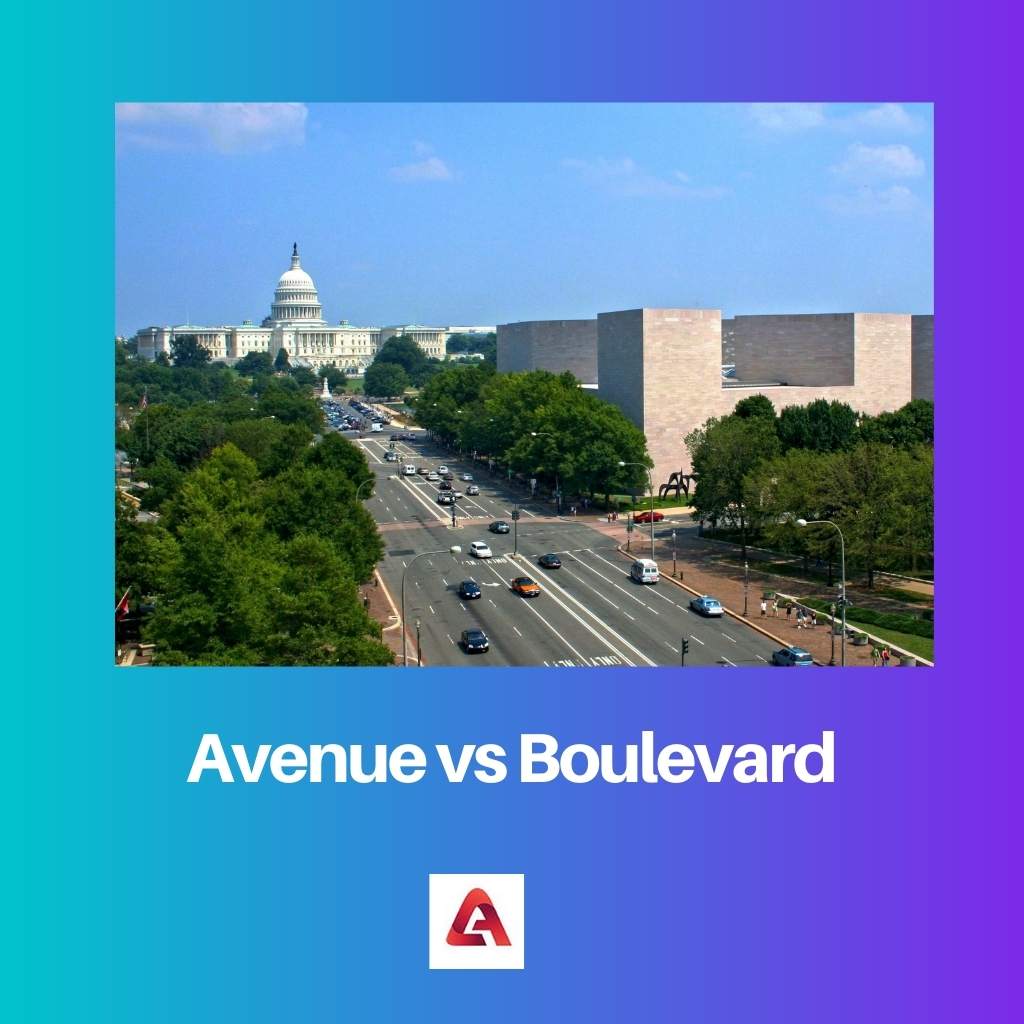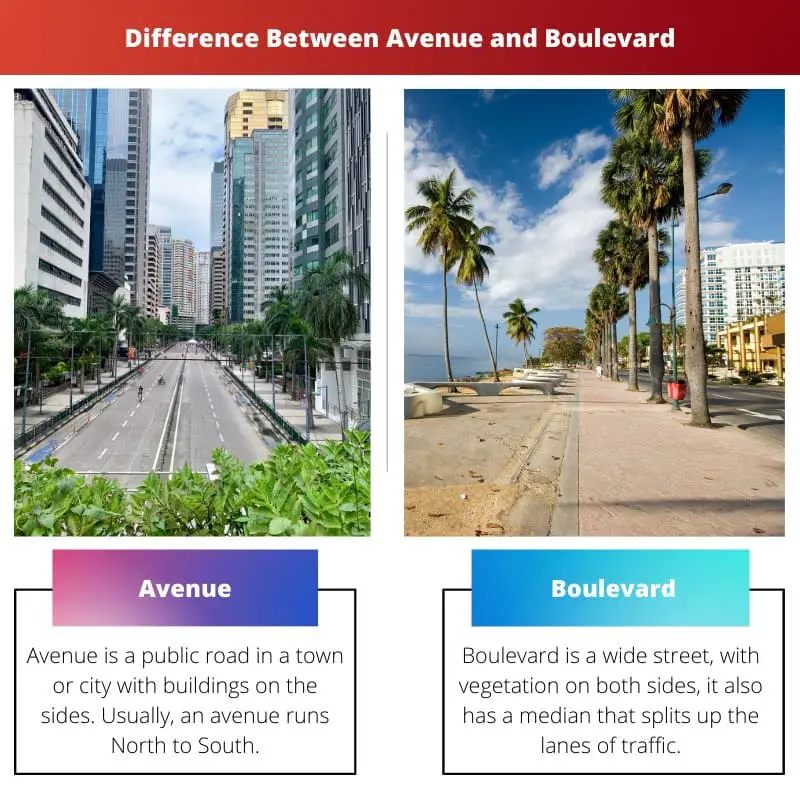Avenue and boulevard can both be seen in an urban area. These are types of roads, just like lanes, and alleys. Many of us do not know the difference between the various types of roads.
Key Takeaways
- An Avenue is a straight, tree-lined road that runs between two points, while a Boulevard is a wider road that has a central median or Boulevard with trees and flowers.
- An Avenue is found in residential areas, while a Boulevard is in commercial areas.
- A Boulevard has multiple lanes and is designed to handle heavier traffic flow than an avenue.
Avenue vs Boulevard
An avenue is a wide road lined with trees and running perpendicular to the blocks in a city. A boulevard is a wide and landscaped street characterized by a median or central reservation, offering more space for pedestrians, greenery, and recreational areas, creating a more scenic and leisurely environment.

Avenue is a single, straight road that has buildings on its sides. Avenue leads North to South which is opposite of the street as the street runs from East to West.
A boulevard is a wide street and thus fulfils more than one function. It has multiple lanes that are divided with the help of the median.
Comparison Table
| Parameters of Comparison | Avenue | Boulevard |
|---|---|---|
| Definition | Avenue is a public road in a town or city with buildings on the sides. Usually, an avenue runs North to South. | Boulevard is a wide street, with vegetation on both sides, it also has a median that splits up the lanes of traffic. |
| Median | An avenue may or may not retain a median. | A boulevard has a median. |
| Sides | The sides of an avenue have buildings. | Generally, the sides of a boulevard possess long lines of trees and vegetation. |
| Lanes | It is a straight road. | It is a multi-lane road with multiple usages. |
| Traffic | Cars and other vehicles move fast on an avenue. | Vehicles are supposed to drive slow on a boulevard. |
What is Avenue?
Avenue is one of the most common roads in an urban area. It is a straight road with buildings on one or both sides. Traffic is not common here, so vehicles run fast here.
A street runs East to West, and an avenue runs, on the contrary, North to South. Avenue des Champs-Élysées of Paris, Fifth Avenue and Madison Avenue of Manhattan, and La Brea Avenue of Los Angeles are a few instances of famous avenues.
Evidence of avenues can be seen from the 17th century. In the late 18th century, England adapted new landscaping for its roads, and thus this aesthetic form of the road came into fashion and replaced the old design of roads.

What is Boulevard?
Boulevard is a typical multi-lane road which can be seen in urban areas. It is a broad and wide street with multiple lanes. These lanes are split up with a median.
A boulevard commonly has vegetation on one or both sides. This successfully makes a boulevard visually delightful and bestows a graphical look upon it.
It is a multi-purpose street, and it has several functions, it accommodates both vehicles and pedestrians, controls the movement of traffic accordingly, and also holds a green space in the urban city.

Main Differences Between Avenue and Boulevard
- An avenue is a straight, single road, while on the contrary, a boulevard is a multi-lane road with multiple purposes and functions.
- On an avenue, vehicles move fast; however, on a boulevard, cars and other vehicles are supposed to drive slowly with caution as vehicles of different sizes use it. It is used by pedestrians as well.

- https://www.jstor.org/stable/215088
- http://apps.azdot.gov/ADOTLibrary/publications/project_reports/PDF/AZ180.pdf

I found the comparison between the functions of avenues and boulevards very intriguing. This article serves as an excellent educational resource.
Indeed, it’s not that we find such in-depth analysis on these topics. Kudos to the author.
I’m genuinely impressed by the depth of this article. It’s not that we come across such thorough and well-researched pieces on urban planning and design.
The historical details about the origin of avenues and boulevards are quite interesting. I appreciate the educational aspect of this article.
The comparison between Avenue and Boulevard is very enlightening. I had no idea about the differences between these two types of roads.
Great explanation of the differences. I found the information about the history of the roads quite thought-provoking.
Yes, it’s indeed an interesting read. The history behind the avenues and boulevards is also fascinating. I’ve learned a lot.
This article does an excellent job of highlighting the nuances between avenues and boulevards. The comparison table is particularly helpful.
I agree. The comparison table really made it clear for me. What a great piece of information!
I appreciate the references provided. It’s clear that this article has been well-researched and offers valuable insights into avenues and boulevards.
Yes, the references add a lot of credibility to the article. It’s evident that the writer has put in a lot of effort.
This is a very informative piece. The evidence of avenues can be seen from the 17th century, which is truly fascinating.
The information regarding the sides and median differences between avenues and boulevards is quite valuable. This article provides a comprehensive overview.
Absolutely. The detailing is top-notch. I’ve learned a great deal from this.
Agreed, it’s rare to find such well-structured and well-explained content about these topics. The detailing is impressive.
The way avenues and boulevards are differentiated here is commendable. The point about the speed of vehicles on the two types of roads is quite interesting.
Absolutely, I found the information about the speed distinctions very thought-provoking. Great work.
The historical context and the origin of the design of avenues and boulevards have been presented remarkably well in this article.
Absolutely, the historical background makes this read truly engaging and compelling.
I couldn’t agree more. The historical context adds a whole new dimension to understanding these types of roads.